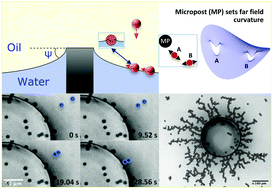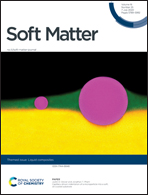Dimerization and structure formation of colloids via capillarity at curved fluid interfaces†
Abstract
Capillary interactions are ubiquitous between colloids trapped at fluid interfaces. Generally, colloids in fluid interfaces have pinned, undulated contact lines that distort the interface around them. To minimize the area, and therefore the energy of these distortions, colloids interact and assemble in a manner that depends on the shape of the host interface. On curved interfaces, capillary interactions direct isolated colloid motion along deviatoric curvature gradients. This directed motion relies on the leading order, long-ranged quadrupolar distortions made by the colloids' undulated pinned contact lines. Here we study pair interactions and dimer formation of colloids on non-uniformly curved fluid interfaces. Pair interaction energies are inferred to be order of 104kBT, and interacting forces are of order 10−1 pN for 10 micron particles adsorbed on interfaces formed around a 250 micron micropost. We compare experiments to analysis for the pair interaction energy, and identify criteria for dimers to form. We also study the formation of trapped structures by multiple particles to discern the influence of the underlying interface shape and the contact line undulations. By comparison to Monte Carlo simulations with potentials of interactions based on analysis, we find that higher order terms in the distortion fields generated by the particles play a major role in the structure formation on the curved interface. These interactions are determined by the particle's contact line and the host interface shape, and can be used to assemble particles independent of their material properties.

- This article is part of the themed collection: Liquid Composites


 Please wait while we load your content...
Please wait while we load your content...
